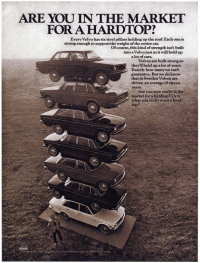But before launching into your own demo ad, it helps to ask yourself two crucial questions.
What Exactly Are You Going to Demo?
This might seem like a no-brainer, but it isn’t.
Granted, the product or service itself might suggest the quality that most begs for a demonstration.
But just because you can demonstrate some cool feature, that doesn’t mean your buyers care about that feature.
In other words, demonstrate the feature or quality that prospective customers care about MOST.
And not what they say they care about. What they actually care about.
Back before the advent of wheeled luggage, when most people checked their suitcases prior to flights, most people wanted rugged, hard-sided luggage that would protect their stuff.
So American Tourister produced a brilliant demo ad showcasing how tough and protective their products were:
That ad worked so well it ran for 15 years, made American Tourister tops in its category, and even inspired a sequel in the early 80s:
But when soft-sided, wheeled luggage and carry on bags became all the rage, what customers wanted changed.
Therefore the type of demo ad that would hit with maximum persuasion changed as well. Check out this amazing demo ad by Samsonite:
The point is to figure out the RIGHT thing to demo as step #1.
How Will You Dramatize the Demonstration?
All demonstrations have some amount of inherent drama.
But some isn’t usually enough. You want to add as much drama and entertainment as possible.
And generally, there are three ways to do this:
1. Increase The Stakes
For an example of upping the stakes to move from boring to gripping, check out this beauty from Union Carbide:
Or this one from Pilkington Glass:
2. Increase the Difficulty
For an example of increasing the difficulty, there’s this demo ad for Vision Saucepans:
Or this all-time classic for Ginsu Knives, where the knife cuts through a soda can before cleanly slicing a tomato:
3. Add Entertainment Through Storytelling
This usually works in combination with upping the stakes or increasing the difficulty, but there are times when those tactics aren’t available, and this becomes a fallback option.
For example, take the challenge of writing a demo ad for a convertible.
Are you really going to demonstrate the top going up and down?
Conceivably you could up the stakes if the top moves fast and it’s about to rain or something.
But that fails the first question: is that really what’s relevant to the buyer?
What customers are buying in a convertible is fun and enjoyment, not a fast-acting lowering or closing mechanism.
This is where storytelling can save the day, as with this brilliant VW ad:
The ad sells the experience through storytelling.
OK, now that you’ve asked and answered the crucial questions, here are a few more points worth thinking about.
How Will You Create Vivid Symbolic Imagery
The Gorilla in the America Tourister ad was a particularly inspired choice, even if it played into misleading stereotypes about gorillas.
In fact, it was inspired BECAUSE it played into stereotypes of luggage-abusing workers at airports, busses, taxis, etc.
And it did so with visceral, cinematic impact.

Sure, you could have also had a man beating the luggage with a baseball bat, but it wouldn’t have felt as true to life as the gorilla.
Nor would it have been anywhere near as entertaining.
For example, having an elephant stand on — or multiple cars piled up on – a car roof is more cinematic than just having “weight” applied to it.
Hence the Volvo ad to the right.
So ask what mental image would burn your persuasion into the minds of customers, and craft your advertising accordingly.
Do You Have What It Takes to Run a Demo Ad?
Demonstration ads are like testimonial ads.
They demand more of the advertiser and the creative team than regular ads, but testimonial and demo ads are persuasive magic.
The only question is: are you and your ad team a match for the challenge?
- Getting a Foot in the Door — Of Perception - November 27, 2025
- What Digital Superstars Know About Offline Advertising - November 17, 2025
- Unmistakable: A Tale of Two Boots and Branding Done Right - November 8, 2025
